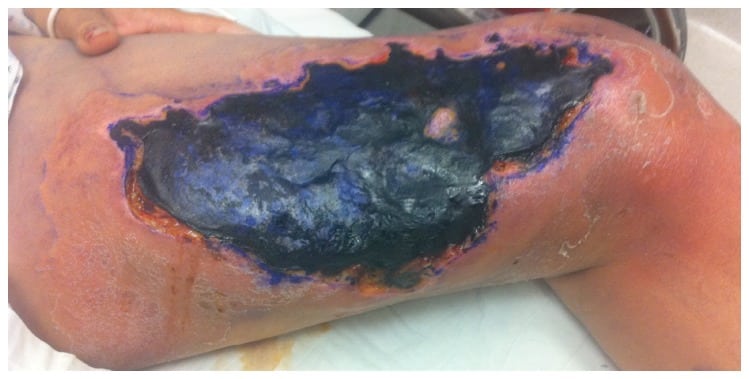| Author | Affiliation |
|---|---|
| Caleb P. Canders, MD | David Geffen School of Medicine at UCLA, Department of Emergency Medicine, Los Angeles, California |
| Jennifer J. Weinberg, MD | David Geffen School of Medicine at UCLA, Department of Emergency Medicine, Los Angeles, California |
CASE
A 42-year-old woman presented with a left lower extremity ulcer. Three weeks prior, she had been struck by a motor vehicle and developed bullae on her thigh, the main area of impact. She could not afford to see a primary doctor, and had been applying a low-cost, over-the-counter topical antiseptic solution to the site since the accident. On examination, she had a 26 by 14 centimeter ulcer on her left medial thigh without tenderness, purulence or crepitance. The ulcer was noted to be bright purple
DIAGNOSIS
Gentian violet (hexamethylrosaniline), the basis of the gram stain, has been marketed as an antiseptic since the 1890s.1 It was used intravenously in the early 20th century to treat sepsis, until being replaced by penicillin and other oral antibiotics. Its exact mechanism of action is unknown, although it is hypothesized to promote free radical formation, inhibit bacterial protein synthesis, and uncouple oxidative phosphorylation. In vitro studies have demonstrated its effectiveness against gram-positive bacteria and Candida, and clinical studies have shown effectiveness against some skin infections, including methicillin-resistant Staphylococcus aureus (MRSA).2,3 Given its low cost, ready availability, and limited adverse effects, topical gentian violet may be a useful treatment in under-developed parts of the world as the incidence of MRSA and other skin and soft tissue infections increases.
Footnotes
Full text available through open access at http://escholarship.org/uc/uciem_westjem
Address for Correspondence: Caleb Canders, MD, David Geffen School of Medicine at UCLA, 924 Westwood Boulevard, Suite 300, Box 951777, Los Angeles, CA 90095. Email: ccanders@mednet.ucla.edu. 7 / 2014; 15:366 – 366
Submission history: Revision received February 14, 2014; Submitted March 3, 2014; Accepted April 2, 2014
Conflicts of Interest: By the WestJEM article submission agreement, all authors are required to disclose all affiliations, funding sources and financial or management relationships that could be perceived as potential sources of bias. The authors disclosed none.
REFERENCES
1 Maley AM, Arbiser JL Gentian violet: a 19 century drug re-emerges in the 21 century. Exp Dermatol. 2013; 22:775-780
2 Berrios RL, Arbiser JL Effectiveness of gentian violet and similar products commonly used to treat pyodermas. Dermatol Clin. 2011; 29:69-73
3 Brockow K, Grabenhorst P, Abeck D Effect of gentian violet, corticosteroid and tar preparations in Staphylococcus-aureus-colonized atopic eczema. Dermatology. 1999; 199:231-236



